Understanding Electric Mobility - MOBI.E
Understanding Electric Mobility
Electric mobility is a modern way of getting around that uses vehicles powered by electricity instead of fuels such as petrol or diesel. Electric cars, buses, bikes, and scooters are all part of this new way of moving through cities.
These vehicles are quieter, more economical in daily use, and, above all, help reduce air pollution. They offer a sustainable and environmentally friendly alternative to meet current and future mobility needs.
The charging infrastructure is the set of equipment and systems that enable the recharging of electric vehicles. It includes charging points, which can be located in public places (streets, shopping centres, car parks) or private ones (garages, businesses), and the electrical grid that supplies the energy.
While combustion engine cars rely exclusively on fuel stations in public spaces, electric vehicles can be charged in both public and private locations, making the process more flexible and convenient.
The operation of the charging infrastructure depends on the interaction between different elements:
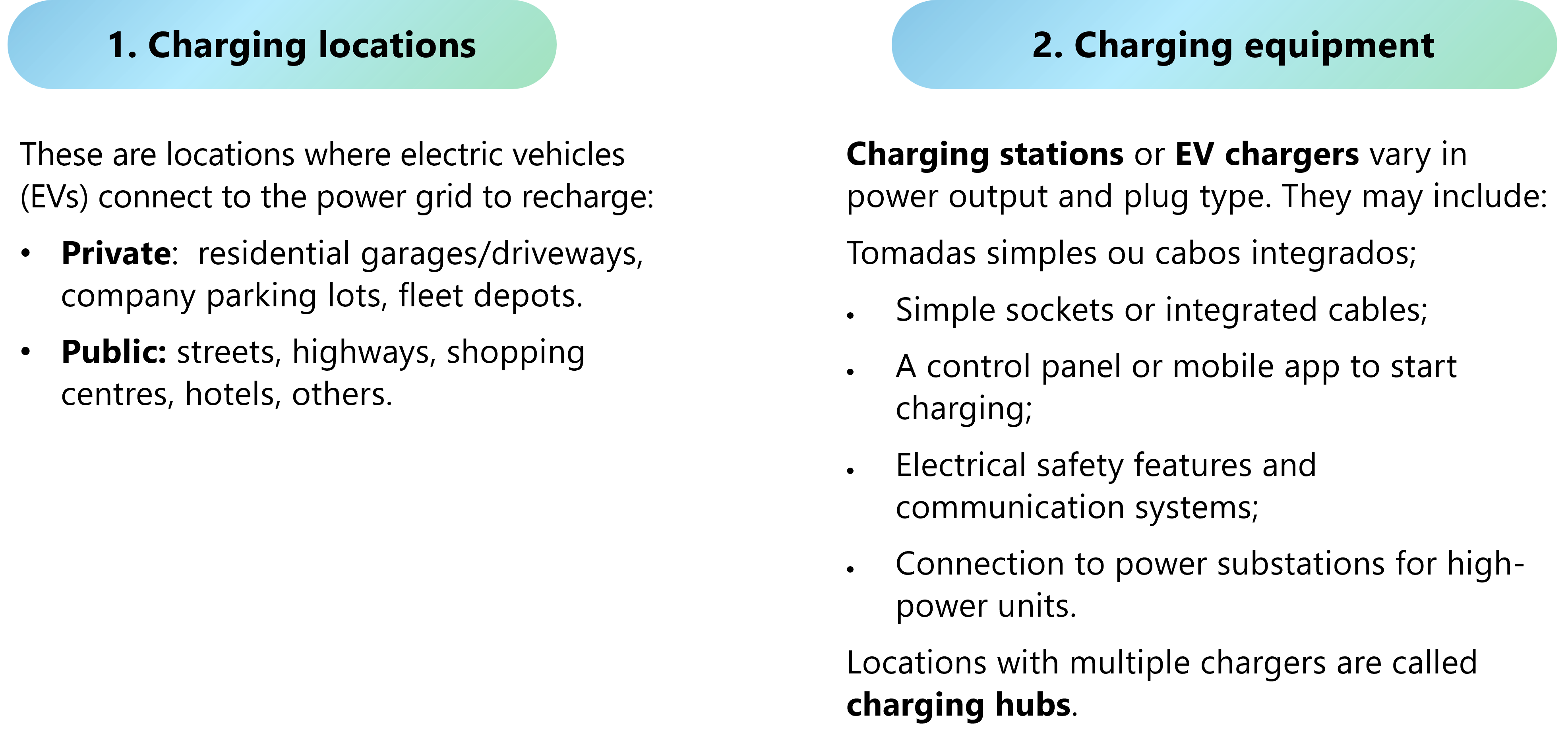
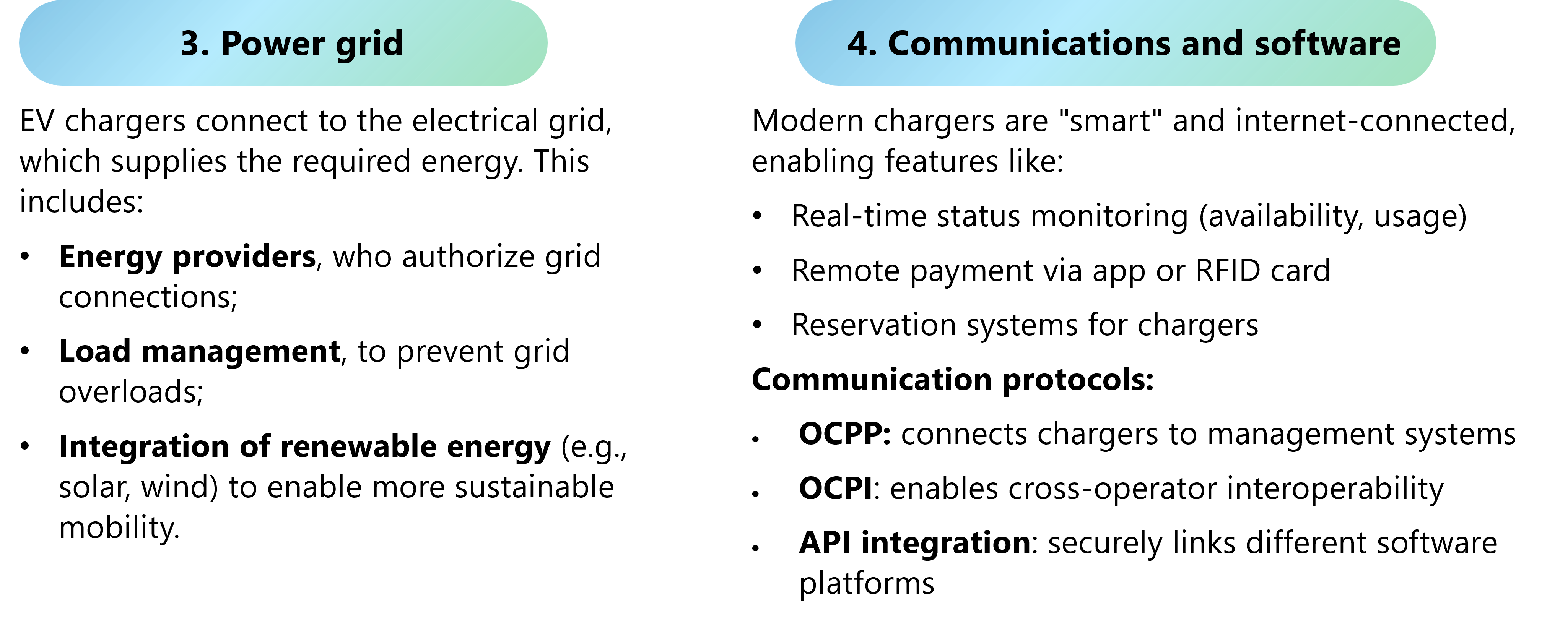
Also noteworthy are:
-
Service Providers (EMSPs): companies that offer services to users, such as charging apps, payment plans, and support;
-
Charging Operators (CPOs): responsible for installing and maintaining the charging points. They ensure the equipment functions properly and plan the network’s expansion;
-
Municipalities and governments, who play a key role:
• Create incentives;
• Set safety regulations;
• Authorise public spaces;
• Plan the network’s growth.
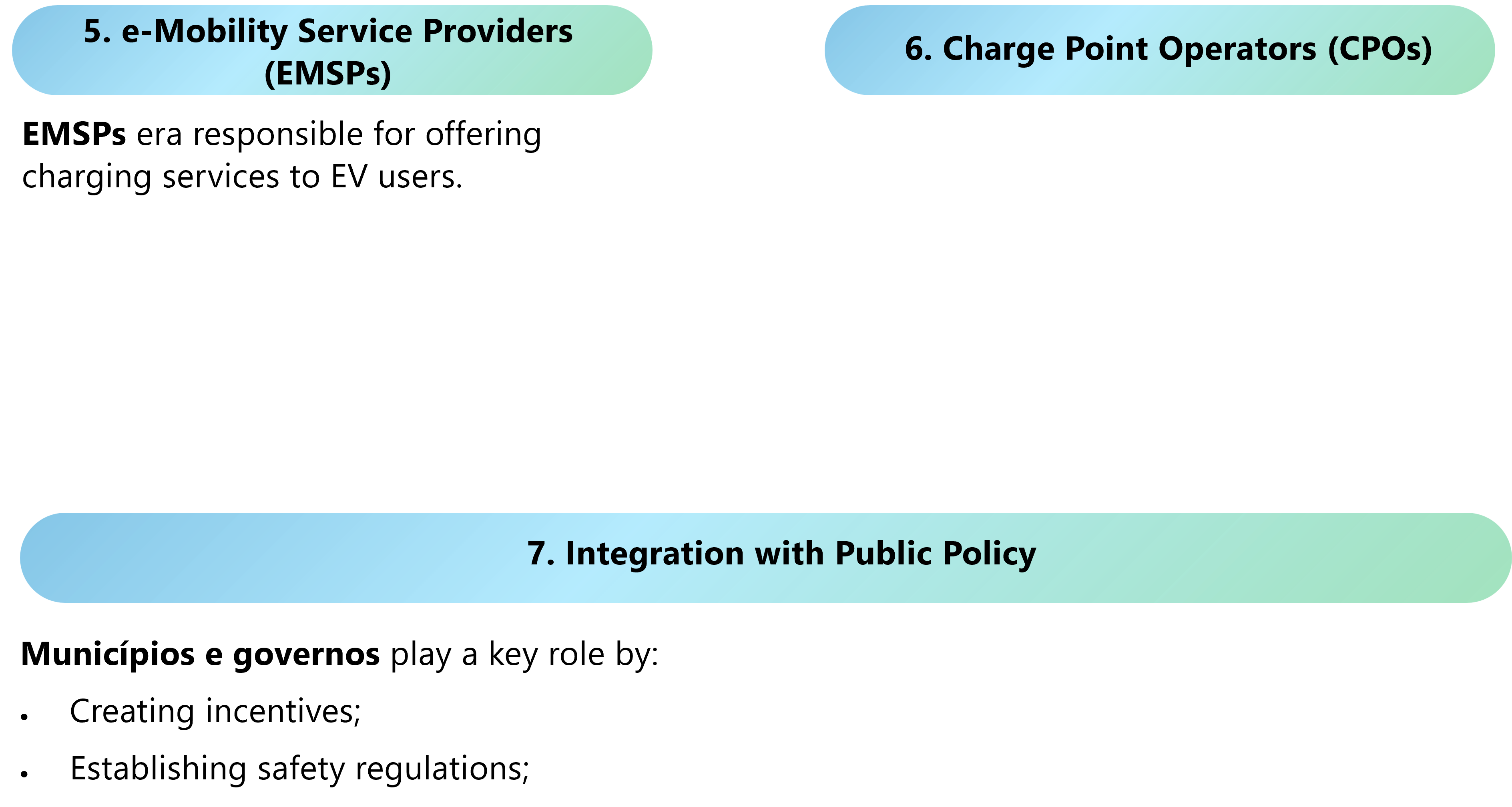
Charging and refuelling are different experiences:
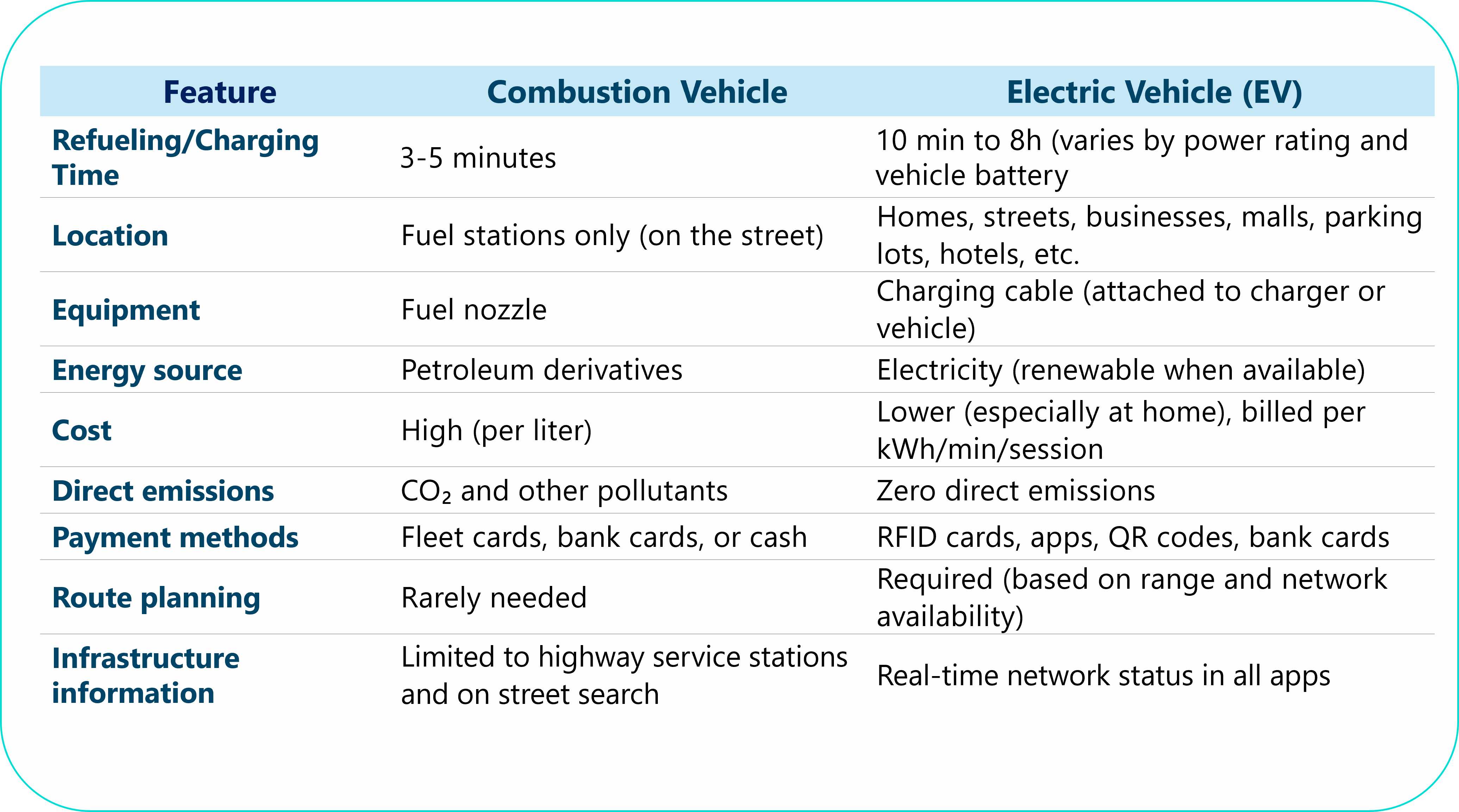
Likewise, charging and payment are distinct actions:

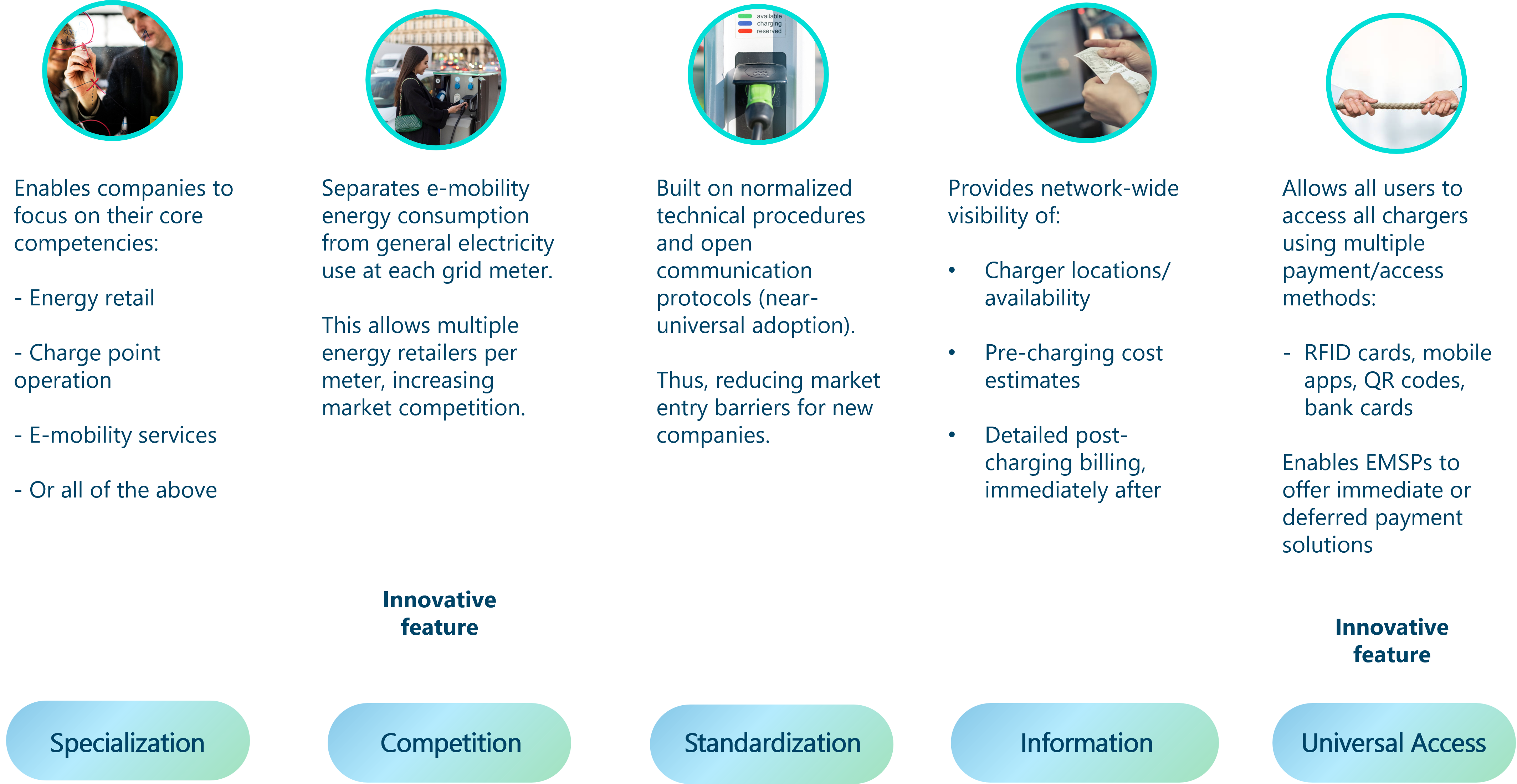
FEATURES OF THE PORTUGUESE MODEL
In Portugal, all charging stations are connected to a single digital information platform, managed by MOBI.E.
This enables real-time sharing of useful data for Electric Vehicle Users (EV users), EMSPs, CPOs, and other regulatory, oversight, academic, and institutional entities.
Examples:
-
Network Status: shows whether charging stations are available or in use.
-
MOBI.Data: data and statistics on electric mobility.
In Portugal, electric vehicle users can charge at any charging point connected to the Mobi.E network, regardless of the operator, using just one electric mobility card or app (issued by an EMSP).
This means that, with a single contract and a single authentication method, users can access the entire national charging network—no need for multiple cards or apps.
This interoperability makes it easier to use electric vehicles, encourages competition among energy providers, and improves the overall user experience
In Portugal, the electric mobility system is integrated with the energy sector.
This integration allows it to operate in the same way across both public and private spaces:
-
CPOs (Charging Point Operators):
• Can install charging stations in private spaces with fewer risks:
-
Lower risk of underuse.
-
Lower infrastructure investment.
-
EMSPs (Electric Mobility Service Providers):
• Can sell electricity in private spaces using the same contracts as in public spaces.
• Increase revenue and enhance customer loyalty.
-
EV Users (Electric Vehicle Users):
a) Private Individuals:
• Can charge company vehicles at home, with the company covering the electricity costs.
• Can share charging points in apartment buildings, with each user paying only for their consumption — reducing the need for high upfront investment.
b) Companies:
• Can contract an EMSP to supply electricity for the entire electrified fleet.
• Can access both public and private charging stations within the MOBI.E network under a single contract.
• Reduce fleet management costs.
• Allow employees to charge their vehicles at company charging points, paying only for the energy they use.
In Portugal, MOBI.E’s digital information platform is technically enabled to collect, in real time, electricity consumption data from all charging points integrated into the Mobi.E network.
This data is transmitted directly to the systems of the Distribution System Operators (DSOs), allowing:
-
DSOs to separate electric mobility consumption from other types of electricity consumption.
-
Functional separation between:
-
Electric Mobility Service Providers (EMSPs) – responsible for energy retail;
-
Charging Point Operators (CPOs) – responsible for managing charging infrastructure.
-
-
Elimination of fixed power capacity charges on electric mobility consumption borne by CPOs, which:
a) Reduces one of the main fixed operational costs;
b) Encourages the installation of charging stations:-
In inland or lower-demand areas;
-
With higher charging capacities.
-
-
Increased competition in electricity sales for electric mobility, enabling any EMSP to supply electricity at any charging station connected to the MOBI.E network.
-
Simplified technical integration and expanded interoperability, as:
a) EMSPs only require a single integration to access all network charging points;
b) CPOs, with a single integration, provide access to all registered EV users, without the need for additional bilateral agreements. -
EV users, with a single electricity supply contract, can access all charging points regardless of the CPO.
In Portugal, charging using the national infrastructure is simple and quick. In just three steps, you can start charging your electric vehicle anywhere on the Mobi.E network:
-
Join – Choose and sign up with an EMSP (Electric Mobility Service Provider). They will provide your contract along with the card or app needed to access the network.
-
Navigate – Use a mobility app or the MOBI.E website to find the most convenient charging station—near your home, workplace, on the road, or while planning a trip.
-
Charge – Go to your selected charging point, authenticate using your card or app, and start charging.
No hassle, no bureaucracy.
Electric mobility becomes easier with a fully interoperable system like MOBI.E.
In Portugal, you can charge your electric vehicle with maximum convenience, choosing the payment method that best suits your needs.
Several options are available:
-
Electric mobility card (EMSP) with a prior contract
This is the most common way to use the network. Payment is made through your contract with the mobility service provider (EMSP), usually on a deferred basis (with later billing). -
Immediate payment with bank card (ad hoc charging without a prior contract)
a. At a payment terminal (POS): For charging points over 50 kW installed from 13 April 2024 onwards, it is possible to pay directly using a bank card. This option complies with the European AFIR regulation.
b. Via QR Code: For charging points of 50 kW or less, also installed from 13 April 2024, you can make an immediate payment using a QR Code available at the charging station, which links to an online payment platform. This option also complies with the AFIR regulation.
With these options, the Mobi.E network ensures simplicity, freedom of choice, and compliance with European standards for payment methods—making access to electric mobility easier for all users.
The MOBI.E network is present across the entire country, including urban, rural, and inland areas.
This means you can charge your electric vehicle with confidence, wherever you are — from large cities to smaller towns.
National coverage ensures greater convenience and safety during travel, allowing you to plan your trips and daily journeys with peace of mind, knowing there is always a charging point nearby.
The Mobi.E model is a successful example of implementing an electric mobility ecosystem based on principles of interoperability, transparency, and technological innovation. Developed and consolidated in Portugal, this system has demonstrated its potential to be replicated in other countries, thanks to its open and adaptable structure, built upon international standards.
Interoperability as a Central Pillar
One of the main strengths of the Mobi.E model is its full interoperability, enabling different Charge Point Operators (CPOs) and Electric Mobility Providers (EMPs) to coexist and collaborate within a single, integrated network. This approach fosters competition, provides users with freedom of choice, and enhances the system’s overall efficiency.
Although based on the separation between those who sell electricity (CEMEs) and those who operate charging stations (CPOs), the model remains highly flexible. For instance, it allows:
-
A company acting as both a CEME and a CPO to offer users integrated tariffs at its own charging points.
-
Electric mobility companies to establish agreements among themselves or with companies from other sectors to offer discounts, promotions, or loyalty programmes to their customers.
Adoption of Standardised International Protocols
The MOBI.E digital information platform is built upon internationally recognised technical protocols such as:
-
OCPP (Open Charge Point Protocol) – ensures communication between charging stations and central management systems.
-
OCPI (Open Charge Point Interface) – facilitates information exchange between operators and suppliers, essential for cross-border interoperability.
-
Open and documented APIs – promote the integration of new operators, mobility applications, and innovative solutions, boosting the system’s scalability.
These standards ensure that the platform is technology- and vendor-agnostic, facilitating replication in different national or regional contexts.
Adaptability to Local Contexts
Despite its common architecture, the Mobi.E model is highly adaptable to the specific regulatory, technical, or operational needs of each country. The platform allows for configuration of tailored rules, tariffs, incentive mechanisms, or legal requirements, while maintaining overall system coherence and integrity.
Transparency, Trust, and Centralised Data
The model is built around a neutral managing entity — MOBI.E — which centralises and validates energy and financial transactions, ensuring transparency among all ecosystem stakeholders. This central role guarantees trust between market participants and the reliability of the information provided to users.
A Future-Oriented Digital Platform
MOBI.E’s digital platform has been designed for continuous evolution, enabling the integration of new features, the connection of various sustainable mobility vectors (such as smart charging or Vehicle-to-Grid), and the capacity to respond to the challenges of the global energy transition.
Conclusion
The Mobi.E model is not only a successful national solution — it is an open, modular digital platform with unique characteristics, ready to be replicated internationally and adapted to different contexts. It is always based on the principles of standardisation, interoperability, and sustainability: a true electric mobility solution for the future.

